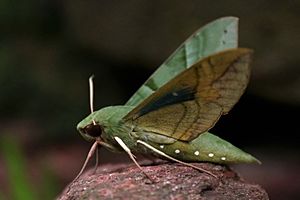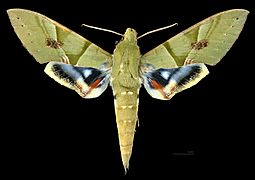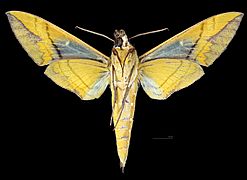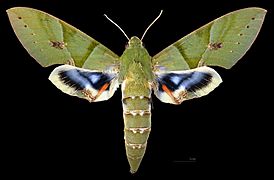Gaudy sphinx facts for kids
The Gaudy sphinx (Eumorpha labruscae) is a beautiful type of moth known for its bright colors. It belongs to a family of moths called Sphingidae, often known as hawk-moths or sphinx moths. These moths are found in many parts of the Americas, from Argentina all the way up to the southern United States.
Quick facts for kids Gaudy sphinx |
|
|---|---|
 |
|
| Sao Paulo, Brazil | |
| Scientific classification | |
| Genus: |
Eumorpha
|
| Species: |
labruscae
|
| Synonyms | |
|
|
Contents
Meet the Gaudy Sphinx Moth
The Gaudy sphinx moth is quite large, with a wingspan of about 4 to 4.75 inches (11 to 12 cm). Its body and front wings are a deep green color. The back wings have cool purple-blue patches, yellow edges, and a red spot near the body. The underside of the moth is a mix of yellow-green and gray-purple.
Like many sphinx moths, its caterpillars dig into the ground to become a pupa. The famous scientist Carl Linnaeus first described this species in 1758.
Where Do These Moths Live?
You can find the Gaudy sphinx moth in many places. They live from Argentina in South America, all the way north through Central America, Mexico, and the West Indies. In the United States, they are found in Florida, Mississippi, South Texas, and Arizona.
Sometimes, strong winds can carry these moths to other areas. They have been seen as far north as Missouri, southern Michigan, Pennsylvania, Maine, and even southern Saskatchewan in Canada.
The Gaudy Sphinx Life Cycle
The life of a Gaudy sphinx moth starts when the female moth lays her eggs. She places them on the leaves of certain plants, which are called "host plants." These usually include grapes (Vitis), vine (Cissus), and Christmasbush (Chromolaena odorata).
When the eggs hatch, tiny caterpillars emerge. They start eating the leaves right away. These caterpillars have a unique look that makes them seem like the head of a snake. This might help scare away predators.
When a caterpillar is ready to change, it climbs down from its host plant. It then digs into the ground to form a pupa. This is a resting stage where the caterpillar transforms into a moth.
When the moth is ready to emerge, the pupa wiggles its way to the surface. The newly emerged adult moth then climbs onto a plant or other surface. It pumps fluid into its wings to make them expand and become strong enough for flight.
At night, female moths release special scents called pheromones. Male moths can smell these pheromones from far away. They fly into the wind to follow the scent and find a female. Adult moths likely get their energy by feeding on nectar from flowers.
Different Types of Gaudy Sphinx Moths
There are two known types, or subspecies, of the Gaudy sphinx moth:
- Eumorpha labruscae labruscae
- Eumorpha labruscae yupanquii (This type is found in the Galápagos Islands.)





